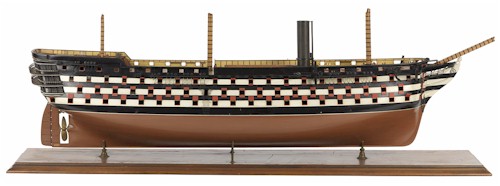

Tower and Town, June 2017 (view the full edition) (view the full edition)The Transition To SteamThe nineteenth century was a time of extraordinary change in warships and the fourth HMS Marlborough exemplifies this. Steam propulsion was augmenting sail from about 1820; it gave a freedom from the wind which opened interesting possibilities and was really useful for tugs getting sailing ships in and out of harbour - think of the grubby tugboat towing the Fighting Temeraire in Turner's evocative picture. Cross channel packets and coastal shipping were quickly steam powered. The problem was that their steam engines burned a colossal amount of fuel; no use for an ocean-going navy. Furthermore the paddlewheels were very vulnerable and occupied the space needed for guns. For 20 years this was a circle that could not be squared and the fourth HMS Marlborough was laid down in 1855 as a wooden battleship, looking much like Nelson's HMS Victory (though twice the size as a stronger method of construction had been found by laying the frames on the diagonal rather than at right-angles to the hull planking). She was driven by a screw propeller which could be lifted out of the water and into a slot at the stern when she was travelling under sail - which was most of the time. This retractable propeller shows clearly on the model. She had a surprisingly long life, serving as flagship of the Mediterranean fleet, eventually serving as an accommodation hulk in Portchester Creek, and not broken up till 1924.  Alexander Kirk-Wilson |